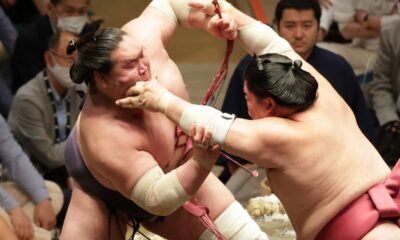
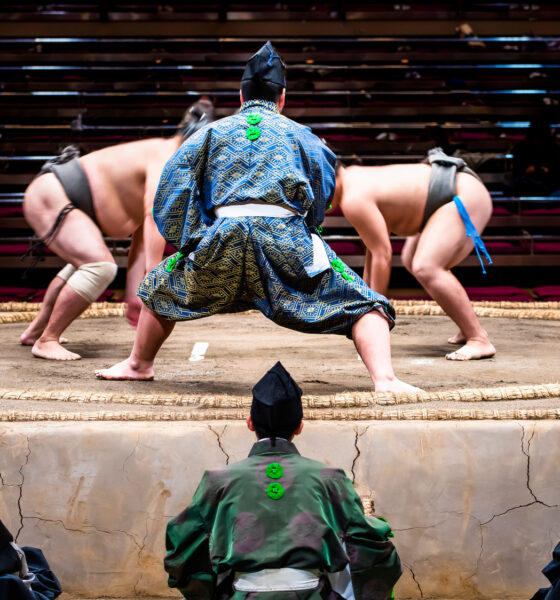
News
Sumo: An Introduction and Guide
The powers that be at VMTV have kindly allowed me to cover the amazing Japanese sport of Sumo wrestling going forward. Before the next tournament gets going this November 14th, it seemed like a good idea to introduce Japan’s ancient sport to those who don’t know the score. Here you will find a basic guide and all the need-to-know information before diving in to one of the best combat sports on the planet.
The History
Sumo is an ancient sport that has been practiced for thousands of years. Japan is the only country in which it is practiced professionally but there are amateur clubs all over the world and world championships won by people from a variety of nations. Sumo started as a ritual dance performed to try and guarantee a good harvest, but it also exists in manuscripts from as early as 712AD which tell stories of the Gods. Legend says two gods had a Sumo bout to decide who would possess the Japanese islands they wanted.
A document from 720AD called the Nihon Shoki tells us about the first match between humans, which apparently took place in 23BC. This of course must be taken with a pinch of salt, having been written so far after the fact, but what is true is that this sport has at least 1400 years of history, as we know a tournament took place in 642AD in the royal court. Until the Middle Ages, Sumo was often fought to the death.

During the Edo period (1603-1868), Sumo began to become more regulated and official sanctioned tournaments started. It was in this era that the first official Yokozuna (the highest rank of Sumo) appeared. Following the influence of the West after 1868, Sumo’s popularity fell. The Emperor Meiji held a tournament in 1884 which increased the popularity of the sport once more. The Japan Sumo Association increased the number of tournaments first from two to four, and then to six a year from 1958. Sumo has remained largely the same in format since that date.
The GOAT
Since I started with the history of the sport, it seemed appropriate to mention the Greatest of All-Time at this point. Like all sports, there is debate over who is the greatest to have done it. There are several candidates, but for me it is a no-brainer. The GOAT is Hakuho, a Mongolian wrestler who became Yokozuna in 2007 and remained so until just this year, when he retired after winning his final tournament.
He has won 45 tournaments, the most ever and is the holder of a host of records including the most undefeated tournaments (16), the most career wins (1187) and most tournaments ranked as Yokozuna (84). Other candidates for the title of GOAT include Taiho (32 tournament wins) who was the only wrestler to win a championship in the top division in every year of his career and Chiyonofuji (31 tournament wins) who wowed the crowed with his incredible technique and strength.

The Season
As mentioned earlier, since 1958 there have been six tournaments held each year. They take place in odd months in the year, so January, March, May, July, September and November. Three tournaments take place in Tokyo. The Hatsu Basho (opening tournament) in January, The Natsu Basho (summer tournament) in May and the Aki Basho (autumn tournament) in September. The Haru Basho (spring tournament) happens in Osaka in March. The other two are named after the locations they take place in, the Nagoya Basho in July and the Kyushu Basho in November, which is held in Fukuoka, the mayor city on the island of Kyushu.
The Athletes
Many scoff or laugh at the size of sumo wrestlers, but these guys are conditioned machines. They undergo insane training regimes at live-in training complexes from young age. Training will normally begin at 5am, with leg exercises designed to strengthen and also increase balance. Training continues through the day with exercises designed to increase agility and flexibility. The wrestlers can only eat twice a day to keep metabolism down, and they eat a meal rich in protein and nutrients but also high calorie. They can eat upwards of 10,000 calories a day to increase body mass and make themselves hard to move. The food is called Chanko and is a type of stew made with vegetables, chicken or pork, or sometimes all three. There is a strict disciplinary code inside the sumo stable, the elders are fed first, followed by the high ranks, and only when they have finished are the low ranking sumo allowed to eat. They are men of extreme discipline, strength, technique and surprising agility.

The Foreigners
There aren’t a lot of foreign wrestlers in Sumo. For now, only one foreign wrestler is allowed at each training stable and they must join before they are 23. That’s not to say foreigners are not successful in Sumo. The GOAT is Mongolian, the 1990s was a successful time for American Sumo wrestlers and there was even a wrestler from the UK. Right now in the ranks there are wrestlers from Mongolia (the most common after Japanese wrestlers), Bulgaria, Georgia and Brazil in the top division.

The Rules
If you step out of the roped-off ring or any part of your body that isn’t the sole of your foot touches the floor, you lose. You can force your opponent out, they can slip over, you can throw them to the ground. Each of these would result in you winning. The referee decides the winner, but there are also judges ringside. If the judges disagree with the referees decision, they have a chat about it and watch a video replay to decide who actually won the bout. If a winner can’t be determined, usually when the two wrestlers touch the floor at the same time, then they replay the bout.
At the top ranks, wrestlers have 15 bouts, one each day. The winner of the tournament is the one who has the most victories at the end of the tournament. Wrestlers tend to be matched against others around their own rank. If two wrestlers are tied for victories at the end of the tournament then there is a playoff bout to decide the winner.
The Techniques
There are many winning techniques allowed in Sumo. To start off with, I’ll explain what is not allowed. There can be no punches, although flat-palm strikes are allowed. Hair-pulling is not allowed, nor are kicks (leg sweeps are okay), scratches, gouges or grabbing the crotch area. If you commit any of these fouls you are automatically disqualified and your opponent is awarded the victory.
The most common winning technique is called Yori-kiri (frontal force-out), where you force your opponent out of the ring by holding his belt and pushing with your bodyweight. After that there is Oshi-dashi (the push-out), Uwate-nage (outside belt throw) Osoto-gake (outside leg trip) and Nodowa (the throat thrust). Watching Sumo, you might see cushions fly into the air as the crowd get excited. This is because a low ranking wrestler (Maegashira rank) has defeated a Yokozuna and earned a kinboshi (gold star). This is a big deal and the crowd get pumped at the sight!

The Controversies
Sumo might be long, storied and traditional, but it’s not without its controversies. The most dangerous to the sport happened in 2011, when police unveiled a match-fixing scandal. 14 wrestlers and stablemasters were involved and some admitted to the police they had fixed matches for money. For the first time since 1946, a tournament was cancelled in the wake of the scandal. The 14 were forced to retire from the sport after being found guilty. The May tournament did go ahead, but without TV coverage, without sponsors and without a trophy presentation. It was won by Hakuho, of course.
In 2010, a scandal involving the Yakuza rocked Sumo. The Japan Sumo Association banned a high-ranking sumo and his coach for betting on sports in an illegal Yakuza betting ring. A further 18 wrestlers were banned from the July 2010 tournament. The chairman of the association announced that Yakuza members were being banned from tournaments. In response, the largest Yakuza group in Japan purchased 50 prominent seats during a tournament so their members would appear on the live TV broadcast.
In a way similar to that you might have heard of in American universities, young Sumo wrestlers can often be subject to hazing when they join a stable. This went to an horrific extreme in 2007 when a 17-year-old Sumo wrestler called Takashi Saito died from injuries suffered in a hazing ritual involving the stablemaster. The stable master hit him on the head with a beer bottle, after which other wrestlers physically abused him further. The stablemaster was sentenced to six years in jail and the Sumo Association forced changes within the stables.
Following these scandals, interest in sumo fell to a very low ebb and with it so did ticket sales. Thankfully, the Japan Sumo Association did a lot of work to improve the reputation of Sumo at this time and interest slowly returned, although to this day it still hasn’t returned to former levels.
The Banzuke

Two weeks before each tournament begins, the Banzuke is released. This is a list of all wrestlers in ranking order. Ranks are decided based on the record in the previous tournament. If you had a winning record in the last tournament you can expect to move up the rankings, and if you had a losing record, you can expect to fall in the ranks. There are 5 named ranks in the top division. These are split into East and West. The top of the list is the Yokozuna, and there are usually two of them (since Hakuho’s retirement, we currently have one). Following that, there are the Ozeki, of which there must be a minimum of two, one for East and one for West. East is ranked higher than West, so the top ranked East Ozeki is higher ranked than the West. After Ozeki comes Sekiwake and then Komosubi. These four ranks make up the San’yaku ranks. The rest of the wrestlers in the top division are in a ranking called Maegashira and are numbered from 1 to 15-17 East and West, depending on the number of wrestlers.
Currently, there is one Yokozuna, two each of Ozeki, Sekiwake and Komosubi, and 1-17 in both East and West Maegashira.
The glossary
Here are some words which will often come up in future articles and broadcasts of Sumo and will be useful to know;
Gyoji – The referee in the ring
Rikishi – The Japanese word for the wrestlers
Dohyo – The ring
Kachi-koshi – A winning record
Make-koshi – A losing record
Mawashi – A wrestler’s belt
Heya – The Sumo stable
Honbasho – A Sumo tournament
Kimarite – A winning technique
Mono-ii – The discussion between judges about the close decision
The Next Tournament
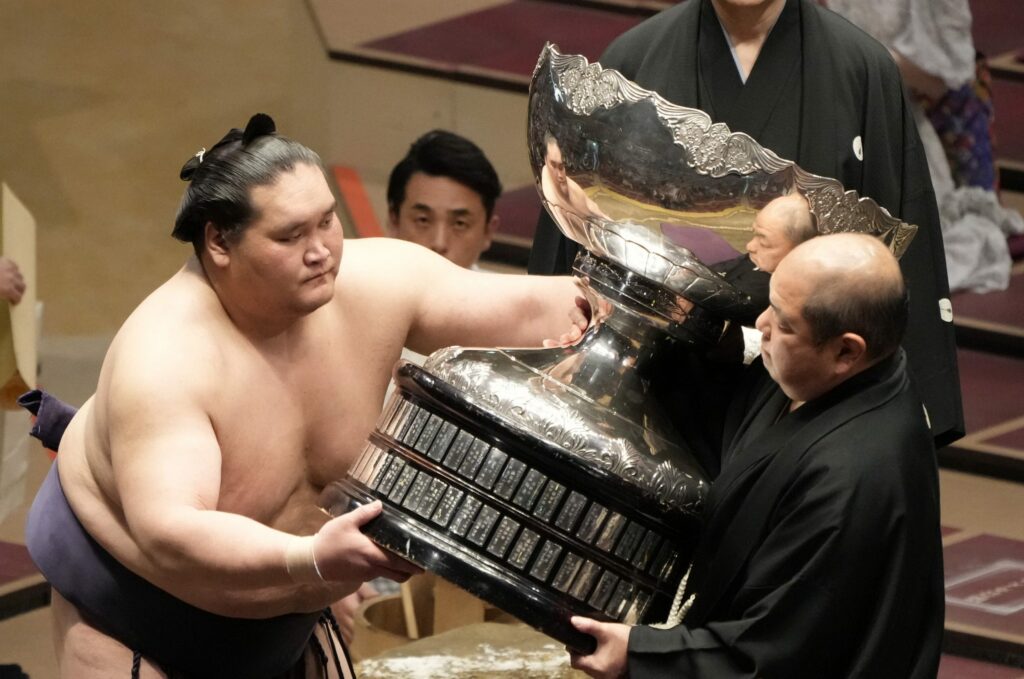
The next tournament is the last one of the year, the Kyushu tournament in November. It is the first tournament since Hakuho retired and left a small power vacuum. The favourite for the tournament will be Terunofuji, who won the last tournament (Hakuho was absent through Covid) and was recently promoted to Yokozuna. Look out for Takakeisho, Shodai and Daieisho who are all capable of winning a championship on their day. In addition, the exciting styles of Wakatakakage, Tobizaru and Ura make them must-watch wrestlers. For outside shots at the title, look out for Myogiryu and Endo who have been making great improvements to their game. This tournament also sees the return of Abi to the top division, after being previously suspended for breaking Covid rules in Japan and working his way back up through the ranks. The retirement of Hakuho has removed the most dominant force in Sumo history, and hopefully the future will see some new tournament winners. That said, Terunofuji is the definite favourite to add to his tally of championships.
Stick with Violent Money to find out what happens in the November tournament. It runs from Sunday November 14th until Sunday November 28th. I will be bringing you the biggest stories and the daily results from all 15 days, so you can follow the tournament even if you can’t watch it. I look forward to bringing news to existing fans of Sumo and hopefully helping create new fans of this ancient sport.
Interviews
Smilla Sundell Recaps Training With Tawanchai & Stamp In Thailand

For a fighter to become the best, it helps to remain humble and focused. And if the opportunity to train with world-class athletes arises, they should grab it with both hands. Ahead of her return to ONE Championship next month, ONE Women’s Strawweight Muay Thai World Champion Smilla Sundell has been doing all that.
The Swedish striker is set to return in the main event of ONE Fight Night 22 on Saturday, 4th May, inside Bangkok, Thailand’s Lumpinee Boxing Stadium, where she’ll defend her crown against Russian ruiner Natalia Diachkova.
Sundell has been dominant across four promotional outings. But she knows she’ll have her hands full with Diachkova, so she recently chose to take some tips from ONE Featherweight Muay Thai World Champion Tawanchai PK Saenchai.
“I did his seminar in Bangkok at PK Saenchai with my friend Matt. We went there and wanted to learn some new skills and see how he did seminars because I want to go to America after my fight to do seminars. I’ve done one now, and I like teaching, so it was fun,” Sundell said.
“There’s no competition in it. He’s like a cat playing with a rat. It’s too easy for him sometimes. He doesn’t even try.”
The strawweight Muay Thai queen sharpens her skills at the Fairtex Training Center in Pattaya, Thailand, alongside other world-class striking talents, like three-sport ONE World Champion Stamp Fairtex.
Stamp’s fun-loving nature has rubbed off on Sundell, but it’s her commitment to never backing down that has truly inspired the 19-year-old sensation.
“She’s always been a happy girl and trains hard every day. She’s basically the same funny girl. Still hungry (to get wins),” Sundell explained.
“I think I learned that you can achieve whatever you like as long as you put in the work. But I learned that from my parents, too. But maybe more practical, in a sense, because Stamp did it in martial arts.”
News
CW 171: Final Card & Broadcast Details

It’s fight week for Glasgow! Cage Warriors – Europe’s Leading MMA Organisation – heads to Scotland for the first time since 2013 with the stacked CW 171 card pitting the nation’s finest against elite opposition from the UK, Europe and beyond!
With the home nation represented in all six of the main card bouts, the atmosphere is set to be electric in the Braehead Arena as CW presents one of its biggest fight nights of all time.
In the main event, blistering KO artist Dumitru Girlean returns to face home favourite Chris ‘The Bad Guy’ Bungard in what is sure to be an electrifying lightweight contest.
Also featuring in high-stakes bouts are title hopefuls Reece McEwan and Aidan Stephen, who face UFC veteran Cameron Else and Italy’s Gianluca Scottoli respectively.
Elsewhere on the card, former title challenger Scott Malone is back in the famous yellow gloves, as he takes on surging contender Nicolas Leblond, while hot prospect Sean Clancy Jr looks to keep his unbeaten run alive against Lucas Rodriguez.
The final CW 171 card is as follows…
Cage Warriors 171: Glasgow | LIVE on UFC Fight Pass
Main Card – 12:30 (PT) | 15:30 (ET) | 20:30 (BST) | 21:30 (CEST)
Lightweight: Dumitru Girlean vs Chris Bungard
Bantamweight: Cameron Else vs Reece McEwan
Welterweight: Lucas Rodrigues vs Sean Clancy Jr
Bantamweight: Gianluca Scottoli vs Aidan Stephen
Flyweight: Nicolas Leblond vs Scott Malone
Bantamweight: Kaique Modesto vs Keir Harvie
Prelims – 08:30 (PT) | 11:30 (ET) | 16:30 (BST) | 17:30 (CEST)
Lightweight: Konstantinos Ntelis vs Jan Quaeyhaegens
Featherweight: Alberth Dias vs Paul McBain
Bantamweight: Jack Eglin vs Daan Duijs
Lightweight: Jordan Little vs Jordan Stronge
Welterweight: Wallison Henrique vs Carlo Pedersoli Jr
Light Heavyweight: Nell Ariano vs Jamie Macdonald
Catchweight (167lbs): Diego Dikson vs Ieuan Davies
Lightweight: Dec Dean vs Michael Blair
Flyweight: Ronal Siahaan vs Igor Wojtas
Featherweight: TBC vs Damon Donald
Bantamweight: Pav Sahota vs Iain Postlethwaite
Welterweight: Mush Aslani vs Khadim Dia
Featherweight: Cornellius Aritonang vs Thomas Hepburn
Cage Warriors 171: Glasgow will air live on UFC Fight Pass and international broadcast partners.
News
UFC 300 – Live Results | Pereira vs Hill

It’s fight day! The milestone event UFC 300 is finally upon us, bringing with it one of the strongest cards ever put together. In the main event, Alex Pereira will defend his light heavyweight belt against former titleholder Jamahal Hill.
For the full results as they happen, look no further!
Note: any point deductions will be denoted with an asterisk and explained at the bottom of the page.
***
Main card (3am GMT+1 – TNT Sports)
(c) Alex Pereira vs (#1) Jamahal Hill – UFC light heavyweight championship bout
(c) Zhang Weili vs (#1) Yan Xiaonan – UFC strawweight championship bout
(c) Justin Gaethje vs (#2 – FTW) Max Holloway – UFC BMF championship bout
(#1) Charles Oliveira vs (#4) Arman Tsarukyan – lightweight title eliminator
Bo Nickal vs Cody Brundage – middleweight bout
Prelims (1am GMT+1 – TNT Sports/UFC Fight Pass)
(#2) Jiri Procházka vs (#5) Aleksandar Rakic – light heavyweight bout
(#7) Calvin Kattar vs (#1 – BW) Aljamain Sterling – featherweight bout
(#5) Holly Holm vs Kayla Harrison – bantamweight bout
(#13) Sodiq Yusuff vs Diego Lopes – featherweight bout
Early prelims (11pm GMT+1 – UFC Fight Pass)
(#10) Jalin Turner vs (#13) Renato Moicano – lightweight bout
(#4) Jessica Andrade vs (#6) Marina Rodriguez – strawweight bout
(#14) Bobby Green vs Jim Miller – lightweight bout
(#8) Deiveson Figueiredo vs Cody Garbrandt – bantamweight bout
***
For more UFC 300 content, stay tuned to Violent Money TV.
-

 News3 years ago
News3 years agoKing of Lethwei Dave Leduc BANNED from Myanmar and competing in the sport
-
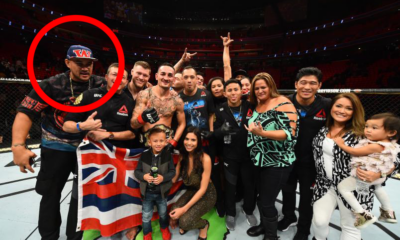
 News3 years ago
News3 years agoSam Kapoi, half-brother of Max Holloway, sentenced for meth possession
-

 News3 years ago
News3 years agoNathias Frederick vs Matthew Bonner revealed for Cage Warriors 123
-

 News3 years ago
News3 years agoUAE Warriors 19 & 20 fight cards
-

 News3 years ago
News3 years agoPaige VanZant is seeking a KO victory over Rachael Ostovich
-

 News3 years ago
News3 years agoThe Latinas of Combate Global set for world domination
-
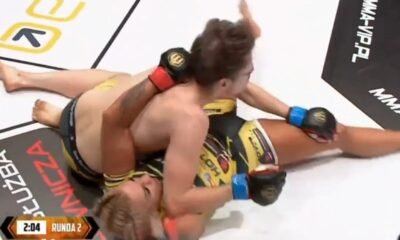
 News2 years ago
News2 years agoFans disgusted at inter-gender MMA fight in Poland
-
Interviews2 years ago
VMTV Vaults | EP.38 – Deniz Ilbay


